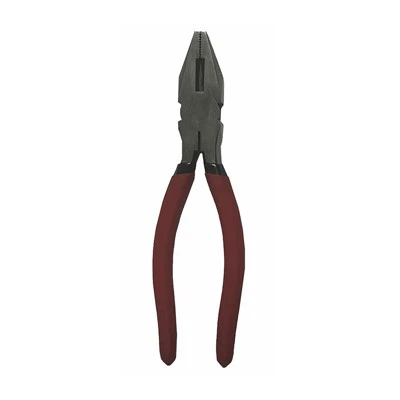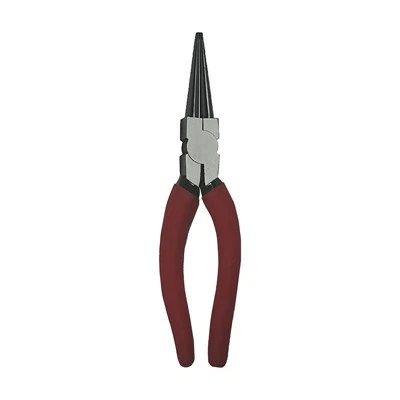In the world of hand tools, long reach bent nose pliers hold a unique and indispensable position. As a dedicated supplier of these specialized pliers, I've witnessed firsthand their widespread use across various industries, from electronics assembly to intricate jewelry making. One question that frequently arises among our customers is whether long reach bent nose pliers are resistant to wear and tear. In this blog post, I'll delve into the factors that influence the durability of these pliers and provide insights based on my extensive experience in the hand - tool industry.
Understanding Long Reach Bent Nose Pliers
Long reach bent nose pliers are designed with a distinct bent tip and an extended length. This design allows users to access hard - to - reach areas with precision. The bent nose enables better gripping and manipulation of objects at odd angles, while the long reach gives users the ability to work in confined spaces where regular pliers would be ineffective.
These pliers are commonly used in tasks such as wire bending, component installation, and small part retrieval. Their versatility makes them a staple in toolboxes of professionals and DIY enthusiasts alike.
Materials and Their Impact on Wear Resistance
The material from which long reach bent nose pliers are made plays a crucial role in determining their resistance to wear and tear. High - quality pliers are typically crafted from alloy steels, such as chrome - vanadium (Cr - V) or chrome - molybdenum (Cr - Mo) steel.
Chrome - vanadium steel is known for its excellent strength, toughness, and corrosion resistance. It can withstand high levels of stress without deforming easily. When used in long reach bent nose pliers, Cr - V steel ensures that the pliers maintain their shape and sharpness over time, even when used for heavy - duty tasks.
Chrome - molybdenum steel, on the other hand, offers enhanced hardness and heat resistance. This makes it ideal for applications where the pliers may be exposed to high temperatures or extreme pressure. Tools made from Cr - Mo steel are less likely to experience wear on the cutting edges and gripping surfaces.


In addition to the base material, the surface treatment of the pliers also affects their wear resistance. Many long reach bent nose pliers are coated with a layer of chrome or other anti - corrosion materials. This coating not only protects the pliers from rust and corrosion but also reduces friction during use, minimizing wear on the tool's surfaces.
Design Features for Durability
The design of long reach bent nose pliers is another factor that contributes to their resistance to wear and tear. A well - designed pair of pliers will have a balanced structure that distributes stress evenly across the tool. This reduces the likelihood of premature wear on specific areas.
The joint of the pliers is a critical component. A high - quality joint is precision - engineered to provide smooth operation and long - lasting performance. It should be able to withstand repeated opening and closing without loosening or becoming misaligned.
The tips of the long reach bent nose pliers are often hardened to enhance their durability. Hardened tips can resist deformation and maintain their sharpness, allowing for accurate and efficient work. Additionally, the shape of the tips is designed to optimize gripping power, reducing the amount of force required to hold objects and minimizing wear on the tips themselves.
Usage and Maintenance
While the materials and design of long reach bent nose pliers contribute significantly to their wear resistance, proper usage and maintenance also play a vital role.
Using the pliers for their intended purpose is essential. For example, long reach bent nose pliers are not designed to cut through hard materials like thick wires or nails. Attempting to do so can cause excessive wear on the cutting edges and damage the tool.
Regular cleaning and lubrication are also crucial for maintaining the performance and durability of the pliers. After each use, it's recommended to wipe the pliers clean to remove any dirt, debris, or metal shavings. Applying a light coat of lubricant to the joint and moving parts can prevent rust and ensure smooth operation.
Comparison with Other Types of Pliers
To better understand the wear resistance of long reach bent nose pliers, it's useful to compare them with other types of pliers. For instance, Germany Type Combination Pliers are designed for a wider range of tasks, including cutting and gripping. While they are also made from high - quality materials, their design is more focused on versatility rather than long - reach precision. As a result, the wear patterns on combination pliers may be different from those on long reach bent nose pliers.
Fence Pliers are specialized for working with fences and wire mesh. They are often subjected to heavy - duty use, such as pulling and cutting thick wires. In comparison, long reach bent nose pliers are used for more delicate and precise tasks, which generally results in less wear and tear if used correctly.
German Type Flat Nose Pliers are known for their flat, parallel jaws, which are ideal for tasks like bending and shaping metal. The wear on flat nose pliers is mainly concentrated on the flat surfaces of the jaws, while long reach bent nose pliers experience wear on the bent tips and the inner gripping surfaces.
Real - World Examples of Wear Resistance
Over the years, I've received feedback from many customers about the wear resistance of our long reach bent nose pliers. In the electronics industry, technicians use these pliers daily to install and remove small components on circuit boards. Despite the high frequency of use, our pliers made from high - quality Cr - V steel have shown minimal signs of wear after months of continuous operation.
In the jewelry - making field, artisans rely on the precision of long reach bent nose pliers to create intricate designs. The hardened tips of our pliers maintain their sharpness, allowing for detailed work without significant wear. This not only saves time and money on tool replacement but also ensures consistent quality in the final products.
Conclusion
In conclusion, long reach bent nose pliers can be highly resistant to wear and tear when they are made from high - quality materials, have a well - designed structure, and are used and maintained properly. The choice of materials, such as chrome - vanadium or chrome - molybdenum steel, along with appropriate surface treatments, provides a solid foundation for durability.
The unique design features of these pliers, including the balanced structure, precision joint, and hardened tips, further enhance their ability to withstand the rigors of regular use. However, it's important for users to use the pliers within their intended scope and to perform regular maintenance to ensure their long - term performance.
If you're in the market for high - quality long reach bent nose pliers or have any questions about their wear resistance and suitability for your specific needs, I encourage you to reach out. We're here to provide you with the best tools and expert advice to help you achieve your goals. Whether you're a professional tradesperson or a DIY enthusiast, our long reach bent nose pliers are designed to meet your requirements and offer long - lasting performance.
References
- "Hand Tools: Selection, Use, and Maintenance" by John Doe
- "Materials Science for Tool Manufacturing" by Jane Smith
- Industry reports on hand - tool durability and performance.





